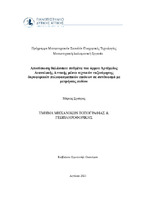| dc.contributor.advisor | Οικονόμου, Εμμανουήλ | |
| dc.contributor.author | Σγούρος, Μάριος | |
| dc.date.accessioned | 2021-03-24T11:46:59Z | |
| dc.date.available | 2021-03-24T11:46:59Z | |
| dc.date.issued | 2021-02 | |
| dc.identifier.uri | https://polynoe.lib.uniwa.gr/xmlui/handle/11400/484 | |
| dc.identifier.uri | http://dx.doi.org/10.26265/polynoe-335 | |
| dc.description.abstract | Αν και η έννοια της ταξινόμησης δεν αποτελεί νέα ιδέα για την κοινότητα της Τηλεπισκόπησης, τα τελευταία χρόνια έχει δοθεί ιδιαίτερη έμφαση στην εφαρμογή της στο θαλάσσιο περιβάλλον, όπου απαιτεί επιπλέον επεξεργασία και μέθοδοι ταξινόμησης οι οποίες επιτύγχαναν μεν στην ξηρά, αλλά στην θάλασσα επαναπροσδιορίζονται. Με γνώμονα την βιβλιογραφία, η παρούσα εργασία καλείται να ξεπεράσει αυτά τα εμπόδια και να καταλήξει στην ταξινόμηση της περιοχής μελέτης έκτασης περίπου 2,68km² χρησιμοποιώντας δορυφορικά δεδομένα Sentinel-2. Δόθηκε έμφαση στα στάδια προ-επεξεργασίας της εικόνας και κυρίως σε εκείνα που αναφέρονται στην αφαίρεση του φαινομένου λάμψης (sunglint) και στην διόρθωση της στήλης ύδατος. Για τις ανάγκες των παραπάνω δημιουργήθηκαν βοηθητικά scripts σε γλώσσα Python, τα οποία επιτάχυναν τις διαδικασίες εξαγωγής των αποτελεσμάτων. Αναπόσπαστο κομμάτι της παρούσας έρευνας αποτελούν οι υπαίθριες εργασίες που πραγματοποιήθηκαν για την συλλογή των δεδομένων αναφοράς και αξιολόγησης των αποτελεσμάτων. Από την ανάλυσή τους προέκυψαν πέντε κλάσεις ταξινόμησης από τις οποίες οι δύο ήταν μικτού υποστρώματος: α) άμμος, β) Ποσειδωνία, γ) βράχια, δ) βράχια με Ποσειδωνία, και ε) άμμος με Ποσειδωνία. Δημιουργήθηκαν δύο σενάρια ταξινόμησης με μπλοκ εκπαίδευσης 2x2 και 3x3, αντίστοιχα. Από τους διαθέσιμους αλγόριθμους ταξινόμησης επιλέχθηκαν ο Artificial Neutal Network, ο Random Forest κι ο Support Vector Machine και μελετήθηκε η συμπεριφορά τους στην υποθαλάσσια ταξινόμηση. Συμπερασματικά, από τους τρεις αλγόριθμους, οι Random Forest και Support Vector Machine σε μπλοκ εκπαίδευσης 3x3 έδωσαν τα καλύτερα αποτελέσματα, ενώ ιδιαίτερο ενδιαφέρον παρουσίασε και η ανάλυση της συμπεριφοράς των κλάσεων μικτού υποστρώματος στους αλγόριθμους που επιλέχθηκαν. | el |
| dc.format.extent | 104 | el |
| dc.language.iso | el | el |
| dc.publisher | Πανεπιστήμιο Δυτικής Αττικής | el |
| dc.rights | Αναφορά Δημιουργού - Μη Εμπορική Χρήση - Παρόμοια Διανομή 4.0 Διεθνές | * |
| dc.rights | Attribution-NonCommercial-NoDerivatives 4.0 Διεθνές | * |
| dc.rights.uri | http://creativecommons.org/licenses/by-nc-nd/4.0/ | * |
| dc.subject | Sentinel-2 | el |
| dc.subject | Τηλεπισκόπηση | el |
| dc.subject | Διόρθωση στήλης ύδατος | el |
| dc.subject | Φαινόμενο λάμψης | el |
| dc.subject | Υποθαλάσσια ταξινόμηση | el |
| dc.subject | Water column correction | el |
| dc.subject | Sunglint removal | el |
| dc.title | Αποτύπωση θαλάσσιου πυθμένα του όρμου Αρτέμιδος Ανατολικής Αττικής μέσω τεχνικών ταξινόμησης δορυφορικών πολυφασματικών εικόνων σε συνδυασμό με μετρήσεις πεδίου | el |
| dc.title.alternative | Seabed mapping in Artemida bay, Eastern Attica, through classification techniques of satellite multispectral images and in combination with field measurements | el |
| dc.type | Μεταπτυχιακή διπλωματική εργασία | el |
| dc.contributor.committee | Kesidis, Anastasios | |
| dc.contributor.committee | Merlemis, Nikolaos | |
| dc.contributor.faculty | Σχολή Μηχανικών | el |
| dc.contributor.department | Τμήμα Μηχανικών Τοπογραφίας και Γεωπληροφορικής | el |
| dc.contributor.master | Γεωχωρικές Τεχνολογίες | el |
| dc.description.abstracttranslated | Although the process of classification is widely known in remote sensing and mostly used in land analysis, in recent years the scientific community has turn its attention to finding new methods for the implementation of classification process into marine areas. The procedures that include water analysis demand further data processing and classification methods that may succeeded in land, however, in the occasion of water they become more complex and need to be redefined. This study uses a Sentinel-2 image and in the light of the existing bibliography we build the method to overpass those demands and reaches the main purpose, which is the classification of benthic habitats in an area of approximately 2.68km². Attention is given to the pre-processing of the satellite image and especially on sunglint removal and water column correction. For the above-mentioned purpose supplementary Python scripts were written to ease the calculations of the mathematical expressions. In-situ measurements comprise integral part of the study and were held to obtain both reference-training and validation data to assess the results. In total five benthic classes were created, of which two referred to mixed seabed: i) sand, ii) Posidonia, iii) rocks, iv) rocks with Posidonia and v) sand with Posidonia. The overall scope was to perform classification in two scenarios, with the first using a 2x2 training block and the second a 3x3 training block. From the available classifiers we chose the Artificial Neural Network (ANN), Random Forest (RF) and Support Vector Machine (SVM) algorithms. In conclusion, both Random Forest and Support Vector Machine using a 3x3 training block provided the highest overall accuracy, while classes with mixed seabed presented an equally mixed behavior when implementing the chosen classifiers. The study indicates the validity in using satellite data coupled with in situ measurements for classifying in particularly Posidonia meadows that represent a highly vulnerable but important environmental factor in the Eastern Mediterranean coastal areas that attract increased population density, socioeconomic activity, recreation, and high estate value | el |


